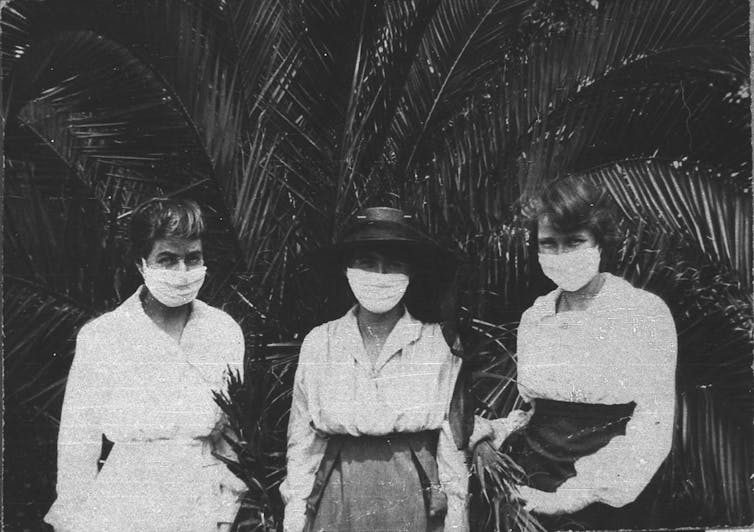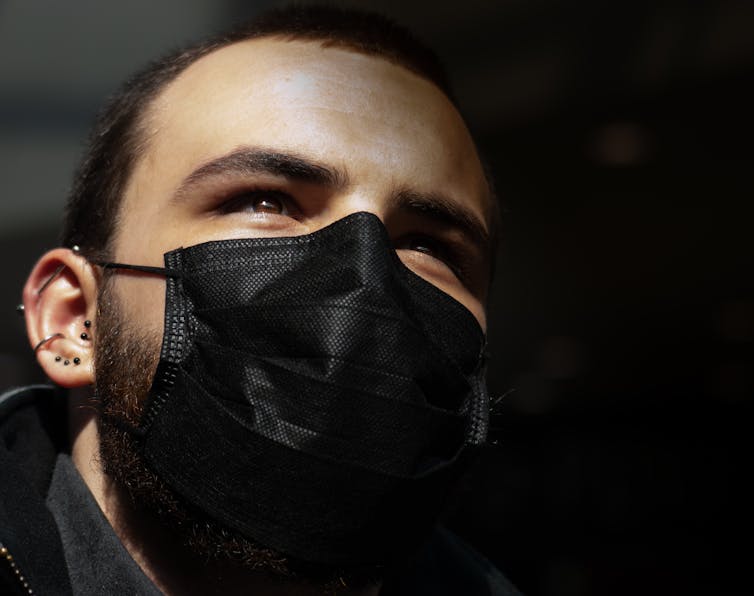Do homemade masks work? Sometimes. But leave the design to the experts
- Written by Emily Brayshaw, Lecturer, Fashion and Design History, Theory, and Thinking, University of Technology Sydney
Once again, global crafting communities are stepping up to help in a crisis, sewing face masks desperately needed in American hospitals to help stop the spread of COVID-19.
People are also increasingly sporting homemade masks to try to stay safe.
But while they might look cute, homemade masks are a sign of both positive social changes and serious social failings.
As America’s Center for Disease Control states: homemade masks are a last resort.
Medical masks in modern times
Surgical masks were first used in France in 1897, but it wasn’t until the great Manchurian plague epidemic in China in 1910 that medical staff and patients started to wear personal protection equipment (PPE) to try to halt the spread of disease.
 Three women wearing face masks during the Spanish Flu pandemic in Australia, 1919.
State Library New South Wales
Three women wearing face masks during the Spanish Flu pandemic in Australia, 1919.
State Library New South Wales
During the 1919 Spanish Flu outbreak masks became mandatory for Australian medical professionals. Other workers, including gravediggers, also started wearing masks and soon they became a fashion statement.
Read more: How Australia's response to the Spanish flu of 1919 sounds warnings on dealing with coronavirus
Deadly virus outbreaks in the last 20 years, including SARS in 2003, Swine Flu in 2009 and Ebola in 2014 have meant images of the general public wearing medical and homemade PPE to combat the spread of deadly viruses are now commonplace.
 Coloured fabric masks are now commonplace.
Laura Dewilde/Unsplash, CC BY
Coloured fabric masks are now commonplace.
Laura Dewilde/Unsplash, CC BY
A global PPE shortage
Medical dramas like Grey’s Anatomy have donated PPE from their costume departments to hospitals. Hollywood’s Costume Designers Guild and the Bavarian State Opera’s costumiers are sewing masks.
Prominent US fashion labels owned by Christian Siriano and Dov Charney are starting to manufacture PPE. French luxury group Kering will provide 3 million surgical masks to France. Gucci will make 1.1 million masks for Italy.
Sewing masks is an activity that can assist people self-isolating at home feel like they are helping to fight COVID-19. Crafting communities like Sew the Curve Flat have formed to meet the challenge.
Masks must be made to strict standards and patterns. These are widely disseminated, but craft groups are still flooded with suggestions from well-meaning people who want to make perceived “improvements” to designs.
Even small changes to mask design can render it useless.
Do they work?
There is conflicting research into the efficacy of homemade masks. Studies into H1N1 viruses show common fabrics may provide only marginal protection against virus-containing particles in exhaled breath. But the general consensus among medical staff is homemade masks are better than nothing when treating patients.
It is imperative crafters follow specifications. The best homemade masks are made from fabric with a tight weave, and have a moisture impermeable layer and/or a pocket for a replaceable HEPA (high-efficiency particulate air) filter. A bandanna around your face won’t do the job.
Wearing face masks is not recommended for the general public and can be dangerous because people overestimate the level of protection offered and neglect social distancing rules and thorough hand washing.
Wearing a mask is generally only useful if you are already sick by slowing the spread of germs.
But if you choose to wear a mask, microbiologist Anna Davies from the University of Cambridge says it must be well-fitting over your mouth and nose. You can’t touch a mask while you’re wearing it, or pull it under your chin for a break. It must be changed as soon as it’s wet and disposed of or placed in the washing machine carefully. You must wash your hands thoroughly before and after handling it.
If you fail to follow these precautions you could get coronavirus from handling a dirty mask.
Where to from here?
Australia is addressing PPE shortages and the Australian army is helping to run three shifts around the clock to increase production at the Med-Con factory near Shepparton.
Melbourne’s The Social Studio has moved its production away from contemporary fashion to making scrubs at cost price for Australian health care workers.
Even so, many hospitals are struggling with limited resources and fear further PPE shortages.
For the general public, the power of wearing homemade masks lies not in their efficacy, but in their signalling of a collective action taken towards safety and protection in in uncertain times.
Read more: Coronavirus: how worried should I be about the shortage of face masks? Or can I just use a scarf?
But seeing desperate hospital staff wearing homemade masks that afford little protection is also a powerful symbol of the need to transform our societies to become more fair and equitable.
As long as hospitals face PPE shortages, the work of crafters will be crucial in combating COVID-19. It is vital that we leave these essential stocks of PPE for medical and auxiliary staff.
For most of us, the best thing to do stop the spread – and protect ourselves – is thorough hand washing and social distancing.
Authors: Emily Brayshaw, Lecturer, Fashion and Design History, Theory, and Thinking, University of Technology Sydney





